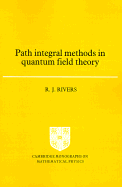Book contents
- Frontmatter
- Contents
- Preface
- 1 Scalar Green functions and their perturbative solutions
- 2 Connected Green functions and their one-particle irreducible components
- 3 Regularisation and renormalisation
- 4 The scalar functional integral
- 5 Series expansions and their summation
- 6 Taking the path integral more seriously
- 7 Quantum theory on non-simply-connected configuration spaces
- 8 Stochastic quantisation
- 9 Fermions
- 10 Quantum electrodynamics
- 11 Non-Abelian gauge theories
- 12 Explicit symmetry breaking and its classical limit
- 13 The effective potential
- 14 Field theory at non-zero temperature
- 15 Field theory at non-zero temperature: real-time formulation
- 16 Instantons
- 17 Composite fields and the large-N limit
- References
- Index
1 - Scalar Green functions and their perturbative solutions
Published online by Cambridge University Press: 04 April 2011
- Frontmatter
- Contents
- Preface
- 1 Scalar Green functions and their perturbative solutions
- 2 Connected Green functions and their one-particle irreducible components
- 3 Regularisation and renormalisation
- 4 The scalar functional integral
- 5 Series expansions and their summation
- 6 Taking the path integral more seriously
- 7 Quantum theory on non-simply-connected configuration spaces
- 8 Stochastic quantisation
- 9 Fermions
- 10 Quantum electrodynamics
- 11 Non-Abelian gauge theories
- 12 Explicit symmetry breaking and its classical limit
- 13 The effective potential
- 14 Field theory at non-zero temperature
- 15 Field theory at non-zero temperature: real-time formulation
- 16 Instantons
- 17 Composite fields and the large-N limit
- References
- Index
Summary
In this book we shall be almost exclusively concerned with the interactions of relativistic particles that are the quanta of elementary fields. There is some ambiguity in the definition of ‘elementary’, but by it we mean local fields whose propagation and interactions can be described by a local Hamiltonian, or Lagrangian, density. Individual terms in these densities describe the basic transformations that the quanta can undergo. For example, if the classical Lagrangian density for a field A has a quartic gA4 interaction we assume that, quantum mechanically, one A-particle can turn directly into three (virtual) A-particles. The way in which these virtual particles further split or recombine determines the way in which A-particle interactions take place.
The aim of this first chapter is to indicate how canonical quantisation (i.e. the Hamiltonian formulation) can be reformulated as statements about how particles interact. The quantification of the qualitative statement that one A-particle can turn into three, or whatever, will occur through a set of relations termed the Dyson–Schwinger equations. In our approach these equations will play a critical role in formulating an alternative quantisation of field theory through path integrals. The path integral formulation, rather than the canonical approach, will be at the centre of all our calculational methods.
- Type
- Chapter
- Information
- Path Integral Methods in Quantum Field Theory , pp. 1 - 25Publisher: Cambridge University PressPrint publication year: 1987



